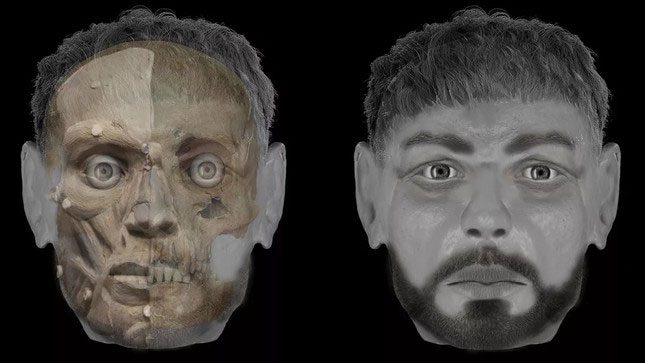According to a new study on a “cold case” from the Middle Ages, over 700 years ago, a “brutal act of violence” ended the life of a young man with four sword strikes to the head.
The lead author of the study, Chiara Tesi, highlights the brutality evident from the wounds in this murder case. This anthropologist at the Center for the Archaeology of Bones and Paleopathology at the University of Insubria in Italy, along with her colleagues, analyzed the victim’s skeleton using modern forensic techniques, including computed tomography (CT) – a three-dimensional X-ray scan – and precise digital microscopy to examine the skull’s injuries.

Reconstruction of the victim in the Cittiglio murder case, who was killed around the mid-11th to 13th century in what appears to be a surprise attack.
The Brutal Murder
Archaeologists discovered the victim’s skeleton in 2006 at San Biagio Church in Cittiglio, a small town in the northern Italian province of Varese.
The oldest parts of the church are believed to date back to the 8th century AD, but the shattered skeleton was found in a grave in a cloister built near the entrance in the 11th century. Radiocarbon dating indicates that the victim was buried there before 1260 AD.
The latest study reveals that the victim was a man aged between 19 to 24 at the time of his murder. It is suggested that he may have been blocked or managed to evade the initial attack from his assailant, although the first blow still inflicted a shallow wound on the top of his skull.
However, as he turned to escape, the victim was subsequently struck twice more, once on the side of the head and the other at the back of the neck. Ultimately, he likely succumbed to exhaustion and fell face down, receiving a final blow to the back of the head that caused instant death.
The latest research suggests that the murder victim was killed by four sword strikes to the head; the first strike caused a minor wound, but the others appeared to have been fatal as he attempted to flee from the attack.
A healed wound on the victim’s forehead indicates that he had experience in combat; while the characteristics on his right shoulder blade may be attributed to archery practice from a young age, possibly suggesting that he regularly went hunting.


















































